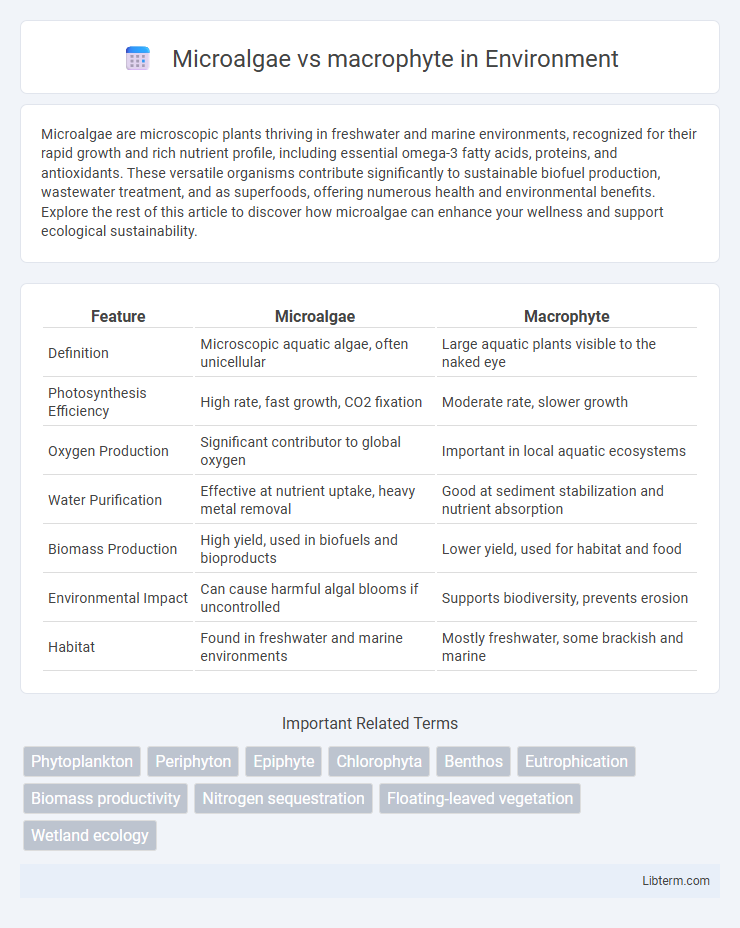Microalgae are microscopic plants thriving in freshwater and marine environments, recognized for their rapid growth and rich nutrient profile, including essential omega-3 fatty acids, proteins, and antioxidants. These versatile organisms contribute significantly to sustainable biofuel production, wastewater treatment, and as superfoods, offering numerous health and environmental benefits. Explore the rest of this article to discover how microalgae can enhance your wellness and support ecological sustainability.
Table of Comparison
| Feature | Microalgae | Macrophyte |
|---|---|---|
| Definition | Microscopic aquatic algae, often unicellular | Large aquatic plants visible to the naked eye |
| Photosynthesis Efficiency | High rate, fast growth, CO2 fixation | Moderate rate, slower growth |
| Oxygen Production | Significant contributor to global oxygen | Important in local aquatic ecosystems |
| Water Purification | Effective at nutrient uptake, heavy metal removal | Good at sediment stabilization and nutrient absorption |
| Biomass Production | High yield, used in biofuels and bioproducts | Lower yield, used for habitat and food |
| Environmental Impact | Can cause harmful algal blooms if uncontrolled | Supports biodiversity, prevents erosion |
| Habitat | Found in freshwater and marine environments | Mostly freshwater, some brackish and marine |
Introduction to Microalgae and Macrophytes
Microalgae are microscopic photosynthetic organisms found in freshwater and marine environments, playing a crucial role in carbon fixation and oxygen production. Macrophytes are larger aquatic plants, including submerged, floating, and emergent species, essential for habitat structure and nutrient cycling in aquatic ecosystems. Both microalgae and macrophytes contribute significantly to aquatic biodiversity and ecosystem function, with microalgae excelling in rapid growth and primary productivity, while macrophytes offer physical habitat complexity and nutrient stabilization.
Biological Characteristics and Differences
Microalgae are unicellular or simple multicellular organisms that perform photosynthesis and thrive in aquatic environments, encompassing diverse groups like diatoms, green algae, and cyanobacteria with rapid growth rates. Macrophytes are complex, multicellular plants, including species such as water lilies, cattails, and pondweeds, typically rooted in sediment and exhibiting specialized tissues like roots, stems, and leaves for nutrient absorption and support. Unlike microalgae, macrophytes exhibit slower growth but contribute significantly to habitat structure and nutrient cycling in freshwater and marine ecosystems.
Growth Habits and Environmental Requirements
Microalgae exhibit rapid growth rates due to their unicellular structure and thrive in diverse aquatic environments with high nutrient availability and light exposure. Macrophytes, being larger multicellular plants, have slower growth and require stable substrates, specific water depth, and clear light conditions for optimal development. Both serve crucial ecological roles but differ significantly in their adaptability to environmental variables such as nutrient concentration, light intensity, and water movement.
Productivity and Biomass Yield
Microalgae exhibit higher productivity and biomass yield compared to macrophytes due to their rapid growth rates and efficient photosynthesis, often producing up to 30 times more biomass per hectare annually. Microalgae can achieve biomass yields exceeding 100 tons per hectare per year, while macrophytes typically yield between 10 to 20 tons per hectare per year. This superior output makes microalgae more advantageous for biofuel production and bioproducts where high biomass density is critical.
Ecological Roles in Aquatic Ecosystems
Microalgae play a crucial role in aquatic ecosystems by driving primary production, supporting the base of the food web through oxygen generation and carbon fixation. Macrophytes contribute to habitat complexity, offering shelter and breeding grounds for diverse aquatic fauna while stabilizing sediment and improving water quality through nutrient uptake. Together, these organisms regulate ecosystem functions, enhance biodiversity, and maintain aquatic environmental health.
Applications in Wastewater Treatment
Microalgae excel in wastewater treatment by efficiently removing nutrients such as nitrogen and phosphorus through rapid photosynthesis and biomass accumulation, while producing valuable bioproducts like biofuels and bioplastics. Macrophytes, including aquatic plants like Typha and Phragmites, contribute by stabilizing sediments, enhancing microbial degradation, and providing surface area for biofilm formation, effectively reducing organic pollutants and heavy metals. Integrating microalgae and macrophytes in constructed wetlands optimizes contaminant removal, improves effluent quality, and supports sustainable wastewater management systems.
Potential for Biofuel Production
Microalgae exhibit a higher lipid content and faster growth rates compared to macrophytes, making them more efficient for biofuel production. Their ability to thrive in diverse aquatic environments without competing for arable land further enhances their sustainability as a bioenergy source. Macrophytes, while larger and easier to harvest, generally yield lower biofuel outputs due to slower biomass accumulation and reduced lipid concentrations.
Nutritional and Commercial Value
Microalgae offer a dense source of essential nutrients, including high concentrations of proteins, omega-3 fatty acids, vitamins, and antioxidants, making them valuable for nutritional supplements and functional foods. Macrophytes, such as aquatic plants, provide dietary fiber, minerals, and phytochemicals, contributing to animal feed and biofuel production with moderate commercial value. The commercial market favors microalgae for pharmaceuticals and nutraceuticals due to their rapid growth rates and high bioactive compound content, whereas macrophytes are primarily utilized in large-scale agriculture and wastewater treatment applications.
Challenges and Limitations
Microalgae cultivation faces challenges such as high nutrient demand, contamination risks, and complex harvesting processes, which increase operational costs and limit large-scale production. Macrophytes encounter limitations including slower growth rates, seasonal variability, and extensive land requirements that restrict continuous biomass availability. Both biomass types require optimized cultivation systems to overcome these bottlenecks for sustainable bioresource development.
Future Prospects and Research Directions
Microalgae offer promising future prospects due to their rapid growth rates, high lipid content, and ability to capture carbon dioxide efficiently, positioning them as sustainable candidates for biofuel production and bioremediation. Research is increasingly focused on genetic engineering and photobioreactor optimization to enhance microalgal biomass yield and metabolite extraction. Macrophytes, with their larger biomass and habitat-forming capacity, remain crucial for ecosystem restoration and water purification, driving research towards integrated wetland management and nutrient cycling enhancement strategies.
Microalgae Infographic

 libterm.com
libterm.com